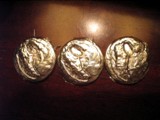 After many delays – not all avoidable – I have revisited my pewter casting work. I’ll start off by thanking my good lady wife Jolief, who assisted with every step of the process in this second effort at pewter casting.
After many delays – not all avoidable – I have revisited my pewter casting work. I’ll start off by thanking my good lady wife Jolief, who assisted with every step of the process in this second effort at pewter casting.I’ll also say upfront that this particular effort serves as an excellent proof of concept for casting items in two-part molds, but my skills as a sculptor have a long way to go.
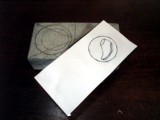 Our first step in this new casting project was to prepare the mold. In our case, we carved our “negative” into just one block of soapstone. I’m not ready to attempt two-sided objects just yet, so the back of the medallion we produced is flat. This isn’t a particularly complicated design. It’s really just an image of a shoe, intended for use as an “Order of the Argent Slipper” medallion.
Our first step in this new casting project was to prepare the mold. In our case, we carved our “negative” into just one block of soapstone. I’m not ready to attempt two-sided objects just yet, so the back of the medallion we produced is flat. This isn’t a particularly complicated design. It’s really just an image of a shoe, intended for use as an “Order of the Argent Slipper” medallion.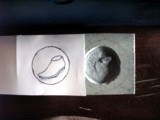 We completed this mold in one day by taking turns at the carving and using modern technological assistance. This isn’t intended to be an A&S competition piece, so I’m not concerned about taking such shortcuts.
We completed this mold in one day by taking turns at the carving and using modern technological assistance. This isn’t intended to be an A&S competition piece, so I’m not concerned about taking such shortcuts.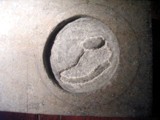 With the design complete, the next step was to carve a path to let metal into the mold and additional paths to let air escape. After doing that, all I needed to do was clamp a flat, blank piece of soapstone onto the carved mold, heat some pewter, and pour it down the funnel.
With the design complete, the next step was to carve a path to let metal into the mold and additional paths to let air escape. After doing that, all I needed to do was clamp a flat, blank piece of soapstone onto the carved mold, heat some pewter, and pour it down the funnel.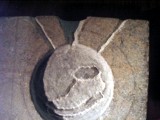 I was surprised at how easily this part of the process worked after the difficulties I had with my attempt at an open-faced mold. The mold filled completely (and often overflowed) on every single try, producing consistent finished pieces that showcased every imperfection in my carving technique with exquisite detail.
I was surprised at how easily this part of the process worked after the difficulties I had with my attempt at an open-faced mold. The mold filled completely (and often overflowed) on every single try, producing consistent finished pieces that showcased every imperfection in my carving technique with exquisite detail.Realizing that the initial effort to make the sole of the shoe separate from the rest of it resulted in an image that looked more like an ice skate, we attempted some correction work on the mold. It’s rather convenient to be able to do touch-up work on the mold this way, then make a new run of castings. Alas, the second round of medallions weren’t that much of an improvement.

Nonetheless, we have now established that two-part pewter castings of this type work very well with the pewter alloy that I have available. For my next effort, I will probably attempt this same work again from scratch, trying to remember that the finished product will be a mirror image of the original (so the shoe points the way I intended) and hand-carving the design to hopefully reduce the number of tool marks in the finished pieces.
EDIT: See my even-more-embarrassing first attempt.

1 comment:
Great Post!!! Find more information by visiting the industrialmetalcastings.com. Find here the updated information on metal casting, die casting, sand casting, casting process
Post a Comment